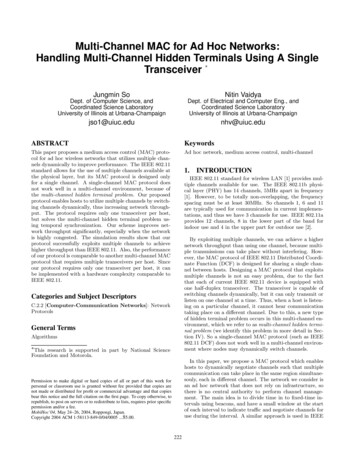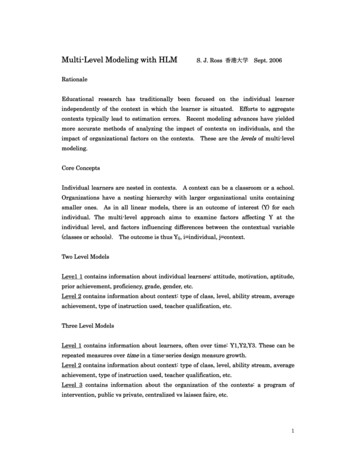
Transcription
Mechanisms for Multi-Level MarketingYuval Emek Ron Karidi†Moshe Tennenholtz‡Aviv Zohar§AbstractMulti-level marketing is a marketing approach that motivates its participants to promotea certain product among their friends. The popularity of this approach increases due to theaccessibility of modern social networks, however, it existed in one form or the other long beforethe Internet age began (the infamous Pyramid scheme that dates back at least a century isin fact a special case of multi-level marketing). This paper lays foundations for the study ofreward mechanisms in multi-level marketing within social networks. We provide a set of desiredproperties for such mechanisms and show that they are uniquely satisfied by geometric rewardmechanisms. The resilience of mechanisms to false-name manipulations is also considered; whilegeometric reward mechanisms fail against such manipulations, we exhibit other mechanismswhich are false-name-proof.1IntroductionSocial networks are everywhere: our e-mail and phone address books, our family relatives, and ourbusiness connections, all define either explicit or implicit social networks. Social networks haveexisted long before the Internet, but their recent web-based form, as exhibited by companies likeFacebook, Twitter, or LinkedIn, made them more tangible. In their new manifestation, socialnetworks have become an attractive playground for viral marketing: the dream of any marketeris that her products will be promoted via “word of mouth” (which relies on social networks). Inorder to make that dream a reality, various forms of marketing have been advocated. The so-calledaffiliate marketing, direct marketing, and multi-level marketing all refer to (overlapping) approachesthat facilitate viral marketing. In this paper, we shall adhere to the term multi-level marketing, asit seems to be the least restrictive one.The fundamental idea behind multi-level marketing is that Alice, who already purchased theproduct, is rewarded for referrals, i.e., for purchases made by Bob as a result of Alice’s promotion.The reward mechanism associated with multi-level marketing may take various forms. In particular, ETH Zurich. yuval.emek@tik.ee.ethz.chMicrosoft Israel R&D Center. ronkar@microsoft.com‡Microsoft Israel R&D Center and Technion–Israel Institute of Technology. moshet@microsoft.com§Microsoft Research Silicon Valley, Mountain View, CA. avivz@microsoft.com†1
Alice may be rewarded for both purchases made by Bob and for Bob’s own referrals in a recursivemanner.The potential to accumulate small rewards from each person to a sizable sum is important asit allows advertisers to attract early adopters and trendsetters that are of great value to them.On the downside, the possibility of gathering a large sum has also inspired more illicit versions ofmulti-level marketing, namely pyramid schemes. These illegal1 mechanisms, essentially based onthe notion of indirect referrals, are not intended to promote a real product, but rather to collectmoney from the social network, although sometimes a product is used in an attempt to cover thenature of the pyramid scheme and bypass legal restrictions. In these cases, customers seldom enjoythe actual product being promoted (when a product is being promoted), but are only participatingin the (usually false) hope of getting rewards from recruiting others.Needless to say that selecting an appropriate reward mechanism is inherent to the design of asuccessful multi-level marketing scheme. Interestingly, despite the popularity of work on information spreading and influence in social networks (see, e.g., the survey in [11]) the study of rewardmechanism design in that context has been almost completely neglected. Such study is the mainsubject of the current paper.Consider for example the following basic coupon driven scheme. Upon purchase of the product,Alice is given coupons that she can distribute among her friends. Then, for any purchase made byBob in which Alice’s coupon is used, Alice is rewarded with appropriate rebates on future purchases.This scheme and similar ones, are easy to implement and have become quite standard in our dailylife. Note that the coupon driven scheme does not exploit indirect referrals: Alice is not rewardedby purchases made with Bob’s coupons or with the coupons of Bob’s referrals.Reward mechanisms that exploit indirect referrals used to be difficult to implement as theyrequire some central authority that keeps track of the referral structure. Information technologyhas made this task much easier. Consider for example the setting in which Alice promotes a productby publishing a link to the seller’s web-site in her blog or Facebook page. Bob can buy the productby clicking on that link; together with the actual product, Bob receives a link to the seller’s web-sitethat he can also publish in his blog or Facebook page. The seller’s web-site can easily identify Bobas a buyer that followed Alice’s link.2 This way a complete record of direct and indirect referrals canclearly be maintained. This ease of implementation makes reward mechanisms that take indirectreferrals into account even more appealing than they have been before.Are indirect referrals really that important? We believe so. To demonstrate their significance,suppose that Bob is a rock music authority and that following Alice’s promotion, he downloads1The current paper does not take legal issues into consideration. In particular, our analysis will not make thedistinction between legitimate multi-level marketing and pyramid schemes.2This can be implemented by associating Alice’s link with a unique identifier. In the current paper we abstractaway this technical issue.2
a new rock song. If Bob recommends this song in his blog, and consequently many other usersdownload this song, then Alice certainly played a major role in the promotion process, even ifshe only had a few direct referrals. A reward mechanism that depends only on direct referrals istherefore bound to miss the bigger picture.The referrals tree model. There are many possible ways to take the social network that formsthe basis of the referral process into account. In principle, one may wish to consider the timesat which promoting messages were sent from one user to another, to consider referrals that werenot followed up by a purchase of the product being promoted, or even to consider the social linksalong which a referral was not made. However, all of this information may not be available to theoriginal seller.3 We therefore take the straightforward approach of looking only at the structure ofsuccessful referrals. For each buyer, we mark only a single referrer for introducing the product toher (in reality, this would typically be specified at the time of purchase). The induced structureof referrals forms a collection of directed trees, each rooted at a node that corresponds to somebuyer that has purchased the product directly from the seller. We shall refer to this tree collectionas the referrals forest, denoted T , and to the rooted trees in T as the referrals trees. We find theassumption that T can be maintained by the seller sufficiently weak.It should be clarified that the referrals forest corresponds to a single multi-level marketingcampaign (typically associated with a single product). Moreover, social network users that didnot purchase the product are not represented in T even if some of their friends attempted atpromoting the product to them. For ease of presentation, we assume that T is fully known whenthe rewards are to be distributed, although all the mechanisms explored in this paper are alsosuited for incremental payments performed online. It will also be convenient to identify the buyerswith their corresponding nodes in T , denoting the reward of (the buyer corresponding to) node uunder the referrals forest T by RT (u).Constraints on the reward mechanism. The reward mechanism is essentially a function thatmaps the referrals forest T to the non-negative real rewards of its nodes. However, not every suchfunction should be considered; specifically, we impose three constraints on the reward mechanisms.The first one is the subtree constraint: RT (u) is uniquely determined by Tu , namely, by the subtreeof T rooted at u. This is sensible, as each user u can really be credited only for bringing in usersshe promoted the product to, either directly (the children of u in T ) or indirectly (lower leveldescendants of u). Moreover, a dependence of RT (u) on the position of u within T (rather than onTu only) may result in an undesirable behavior on behalf of u: in some cases u is better off delayingthe purchase of the product after receiving a referral in hope for a “better” offer, i.e., for a referral3In some social networks such as Facebook there is often more explicit knowledge of social connections, butgeneral referral systems do not necessarily have all the information about the underlying social structure and maynot be able to track messages in the network.3
that would place u in a better position within T .One of the consequences of the subtree constraint is that there is no point in dealing with thereferrals forest T in full, but rather focus on trees which are rooted at the nodes whose rewardwe are trying to calculate. In other words, the reward mechanism is completely specified by thefunction R(T ) that maps the rooted tree T to the non-negative real reward of its root (which maybe an internal node within the whole referrals forest).The second constraint that we impose on the reward mechanism is the budget constraint: theseller is willing to spend at most a certain fraction φ 1 of her total income on rewarding herbuyers for referrals. Given that the price of the product is π, this means that the total sum ofrewards given to all nodes is at most φ · π T . We assume without loss of generality that π and φare scaled so that φ · π 1. Thus,XR(Tu ) T .u TThe third constraint is the unbounded reward constraint: there is no limit to the rewards onecan potentially receive even under the assumption that each user has a limited circle of friendsin the underlying social network (imposing a limited number of direct referrals). Formally, theunbounded reward constraint dictates that there exists some positive integer d (a property of thereward mechanism) such that for every real R, there exists some tree T of maximum degree d (i.e.,every node has at most d children) such that R(T ) R. In particular, this constraint implies thatthe reward mechanisms we consider must take indirect referrals into account.Our results. We begin our exploration of reward mechanisms with a well known family of mechanisms, namely, geometric reward mechanisms. Under these mechanisms, the contribution of anode to the rewards of its ancestors in the referrals tree decreases exponentially (by a fixed factor)with the distance from these ancestors. Three desired properties of geometric reward mechanismsare listed: additivity, child-dependence, and depth-level-dependence. We show that these threeproperties fully characterize the family of geometric mechanisms in the sense that any mechanismthat satisfies all three properties must be a geometric mechanism. (This may explain why pyramidschemes typically rely on geometric reward mechanisms or some close variant of them.) We go onto show that none of the properties is redundant: if any one of the three is left out, alternativereward mechanisms can be found that possess the remaining three.We then look at one more important property of reward mechanisms, namely, resilience tofalse-name manipulations (a.k.a. Sybil attacks). The geometric mechanism family turns out to besusceptible to manipulations by users that can create false identities. In fact, we show that mechanisms that are resilient to false-name manipulations cannot guarantee a user some constant fractionof the reward of even its least influential child. Moreover, it turns out that even if one replacesthe child-dependence and depth-level-dependence properties with the much weaker monotonicity4
property, resilience to false-name manipulations is still impossible. On the positive side, we presentand analyze two reward mechanisms that maintain resilience to false-name manipulations; the twomechanisms differ in their level of resilience and ease of implementation.Related work. The general idea of diffusion of opinions and conventions in societies has for longbeen a topic of study in the social sciences [15, 9] and got attention by game theorists (e.g., [20])and AI researchers (e.g., [16]) among others, quite a while ago. The effects of the social structureon emergent behavior and norms has also been studied, e.g., in [14, 17].The more explicit algorithmic questions that arise when one considers an endeavor such asviral marketing have been posed more recently. The original question of how to select a good setof influential users has appeared in a seminal paper by Domingo & Richardson [8], and has laterbeen explored (with various related models) in a series of papers, e.g. [7] and many other followingworks [10, 3, 5]. These generally assume that the spread of information in the social networkoccurs through some contagion model (i.e., that a user is more likely to be “infected” with anidea if more of her neighbors are) in which users do not explicitly exert effort. The rigorous studyof incentive design for facilitating diffusion or product adoption was typically left without properexplicit treatment, and all works we are aware of in the context of viral marketing do not try toinfluence the amount of effort exerted to spread the information further.The issue of incentives in social networks has however received attention in other particularcontexts. For example, fair distribution of costs/gains of members in a network, using standardpower indices from cooperative game theory, such as the Shapley and Banzhaf values has been asubject of study (see e.g., [13, 4, 2]). However, these do not provide a general rigorous study ofreward mechanisms for social distribution. Kleinberg & Raghavan [12] consider a setting that isperhaps the most similar in spirit to our own, in which they elicit effort from agents that forwardqueries in a social network. Unlike our setting, they allow each agent that receives the query andforwards it to offer its own reward for a successful answer. The final rewards are only allocatedalong the path to the agent that gave the answer as each agent along the way receives the reward forpassing the answer back along the path. A similar reward mechanism (that was more structured)was used by the team from MIT that won the DARPA network challenge [1].Finally, our work also deals with the issue of Sybil attacks that have appeared in many othercontexts such as reputation mechanisms [6], combinatorial auctions [18], and social choice [19].2PreliminariesUnless stated otherwise, all trees addressed in this paper are assumed to be finite and directed fromthe (unique) root towards the leaves. A typical tree will be denoted by T ; its root is denoted by r.We use the standard (directed) tree notions of parent, child, leaf, descendant, and ancestor in their5
natural sense; the parent of a (non-root) node u in T is denoted pT (u). The degree of node u T ,denoted degT (u), is just the number of children u has in T . Given two nodes u, v T such thatu is an ancestor of v, we define the distance from u to v, denoted δT (u, v), as the number of hops(i.e., edges) along the unique path in T leading from u to v; the distance from u to itself is definedto be δT (u, u) 0. If δT (u, v) k 0, then we refer to u as the k th ancestor of v. We denotethe subtree of T rooted at u by Tu . The height of T , denoted h(T ), is defined to be the maximumdistance from r to any leaf in T ; the height of u in T , denoted hT (u), is simply h(Tu ). The depthof u in T , denoted depT (u), is the distance δT (r, u) from the root of T to u. When the tree T isclear from the context, we may omit the subscripts and simply write p(u), deg(u), δ(u, v), h(u),and dep(u).A reward mechanism is a function that maps a non-negative real reward R(T ) to every finiterooted tree T . We think of T as a (subtree of a) referrals tree and of R(T ) as the reward of theroot r of T . (Recall that defining the reward in that manner is made possible due to the subtreeconstraint requiring that the reward of a node in the referrals forest depends only on its subtree.)The profit of r is actually R(T ) π as r paid π 1 for purchasing the product when she joined thePreferrals forest. By the budget constraint, it is assumed that u T R(Tu ) T . The unboundedreward constraint guarantees the existence of some positive integer d such that for every real R,there exists some tree T of maximum degree d such that R(T ) R. The notation RM (·) is usedwhen it is important to emphasize that the function R(·) is associated with the reward mechanismM.3The Geometric MechanismIn this section we focus on the following family of reward mechanisms, referred to as geometricmechanisms. Given two constants 0 a 1 and b 0 such that b 1 1/a, the reward from areferral tree T under the (a, b)-geometric mechanism is defined to beR(T ) Xadep(u) · b .u TThe constraints on a and b ensure that the amount contributed by each node to the reward of itsancestors will not exceed 1. This simple mechanism is very popular with pyramid schemes; as wewill show soon, this is no coincidence. Let us begin by defining and discussing three basic propertiesof reward mechanisms:Additivity (ADD): We define the operation on trees such that if T1 , T2 are trees, then T1 T2 isthe tree formed by contracting (or merging) the roots of T1 and T2 . ADD is then stated as follows:R(T ) R(T 0 ) R(T T 0 ).This property suggests that if two disjoint trees are merged at the root, then the reward of theroot is exactly the sum of the rewards of the two original trees. Generally speaking this property6
implies that the reward to each node can be independently attributed to the subtrees rooted at itschildren.Child Dependence (CD): The reward of the root is uniquely determined by the rewards of itschildren. This property ensures that the actual computation of the rewards can be performedlocally. In fact, we shall consider a weaker condition for this property: If the root of T has a singlechild u, then R(T ) is uniquely determined by R(Tu ). This is captured by a function χ : R 0 R 0(a property of the mechanism) so that R(T ) χ(R(Tu )).Depth Level Dependence (DLD): R(T ) is uniquely determined by the number of nodes on eachdepth level in T . We denote by dk the number of nodes of T at depth level k 0, and the infinitevector containing these numbers for all depth levels by d (d1 , . . . , dh , 0, 0, . . . ), where h is theheight of the tree. Let D be the set of all such vectors, i.e., the set of all infinite vectors over Z 0with a strictly positive prefix followed by a countably infinite suffix of zeros. Then DLD implies thatthere exists some function f : D R 0 (a property of the mechanism) such that R(T ) f (d).This property essentially means that the credit for a referral depends solely on how direct (or bettersaid, indirect) this referral is.Theorem 3.1. A reward mechanism satisfies DLD, ADD, and CD if and only if it is a geometricmechanism.To prove the theorem, we will need the definition of the following additional property:Summing Contributions (SC): There exists a sequence {ck }k 1 of non-negative reals such thatR(T ) Xu Tcdep(u) X#nodes at depth level k · ck .k 1That is, SC implies that each node in the tree T contributes some independent amount to the root,and that amount depends only on its depth. The following lemma reveals the connection betweenthis property and the ones we have already defined.Lemma 3.2. A reward mechanism satisfies SC if and only if it satisfies DLD and ADD.Proof. We start with some useful notation. Let d k denotes the infinite vector d after the firstk elements have been removed, i.e., d k (dk 1 , dk 2 , . . . ). We denote by m d the infinitevector that starts with the element m and continues with the elements of the infinite vector d, i.e.,m d (m, d1 , d2 , . . . ). Finally, we denote the all-zeros infinite vector by 0 (0, 0, . . . ).The direction in which SC implies DLD and ADD is trivial. We shall establish the converse directionusing an inductive argument. Specifically, we prove by induction on k that for every k 0, there7
exist non-negative reals c1 , . . . , ck and an additive function4 gk : D R 0 such thatR(T ) kXci · di gk (d k ) .i 1The base of the induction, for k 0, is satisfied by setting g0 (d) f (d), where f is the functionpromised by DLD. The additivity of g0 is then guaranteed by ADD.For the inductive step, we assume that there exist some non-negative reals c1 , . . . , ck 1 and anadditive function gk 1 : D R 0 such thatR(T ) k 1Xci · di gk 1 (d k 1 ) .i 1The assertion for k is established by settingck gk 1 (1 0) ; andgk (d) gk 1 (1 d) ck .To verify that the function gk is indeed additive, we employ the additivity of gk 1 , observing thatgk (d e) gk 1 (1 (d e)) ck gk 1 (2 (d e)) gk 1 (1 0) ck gk 1 (1 d) gk 1 (1 e) 2 · ck gk (d) gk (e) .The proof of the inductive step can now be completed due to the inductive hypothesis sincef (d) k 1Xci · di gk 1 (d k 1 )i 1 k 1Xi 1k 1Xi 1k 1Xi 1kXci · di gk 1 (dk d k )ci · di gk 1 (1 d k ) gk 1 ((dk 1) 0)ci · di gk (d k ) ck (dk 1) · ckci · di gk (d k ) .i 1In this context a function g : D R 0 is said to be additive if g(d d0 ) g(d) g(d0 ), where the summationin d d0 is coordinate-wise.48
The lemma follows by taking k h(T ) as every additive function g must satisfy g( 0) 0 (bydefinition, g( 0) g( 0 0) 2 · g( 0)).Theorem 3.1 is established by showing that the contribution values ck form a geometric progression.Lemma 3.3. A reward mechanism satisfies SC and CD if and only if it is a geometric mechanism.Proof. It is trivial to show that a geometric mechanism satisfies both properties, so we focus onthe converse direction. Let us restrict our attention to a specific class of trees: For n 1 andm 0, we denote by T (n, m) the tree consisting of n m nodes organized as a path of length n 1emerging from the root with the last node in this path having m children, all of which are leaves.Refer to Figure 1 for illustration.Recall that SC implies the existence of constants c1 , c2 , . . . that determine the contribution ofnodes at each depth level to the reward of the root. We first argue that ck must be strictly positivefor every k 1. To that end, suppose that ck 0 for some k 1 and consider the trees T (k , m)and T (k , m0 ) for some m, m0 0, m 6 m0 . SC implies that R(T (k , m)) R(T (k , m0 )) sinceck 0. By CD, we conclude that the same holds for T (k 1, m) and T (k 1, m0 ), namely,R(T (k 1, m)) R(T (k 1, m0 )), because both the root of T (k 1, m) and that of T (k 1, m0 )have a single child whose reward is R(T (k , m)) R(T (k , m0 )). This implies that ck 1 must alsobe 0 and by induction, that ck 0 for every k k . But this contradicts the unbounded rewardconstraint: if ck 0 for every k k , then no tree T of maximum degree d can provide a reward greater than 2 · dk .So, assume hereafter that ck 0 for every k 1. In attempt to simplify the analysis, we shallimpose another assumption on the contribution values ck . Specifically, we assume that each ck isrational, so that ck xk /yk for some positive integers xk and yk . We later on outline how thisassumption can be lifted.Let us compare the reward that is given to the root node in two specific T (n, m) trees (recallthat a T (n, m) tree has one node at each level 0 to n 1, and m nodes at level n):k 2XR(T (k 1, xk · yk 1 1)) i 1k 1X i 1k 1X ci (xk · yk 1 1) · ck 1ci xk 1 · xkci xk 1 · yk · cki 1 R(T (k, xk 1 · yk )) .(1)Now, observe that CD implies that if R(T (n, m)) R(T (n0 , m0 )), then R(T (n 1, m)) R(T (n0 9
Figure 1: T (n, m) for n 4 and m 10.1, m0 )). By applying this observation to Equation 1, we conclude thatR(T (k, xk · yk 1 1)) R(T (k 1, xk 1 · yk )) .SC then implies thatk 1Xci (xk · yk 1 1) · ck i 1kXci (xk 1 · yk ) · ck 1 ,i 1hence xk · yk 1 · ck (xk 1 · yk ) · ck 1 . It follows that(ck )2 ck 1 · ck 1 ,(2)which implies a geometric progression (ck is the geometric mean of ck 1 and ck 1 ).Recall that our proof thus far only works if all ck ’s are rational numbers. We can extendthe proof to irrational numbers if we add a requirement on the continuity of the function thatdetermines the rewards of a parent from the reward of its children. If the ck ’s are not rational,it is possible to approximate them as closely as one wishes with rational numbers xk /yk and withthe extra assumption, the derivation above results in an equation similar to Equation 2 which ismodified with terms that represent the error in the approximation of ck . As this error can be madearbitrarily small, Equation 2 holds even for irrational values.Another appealing property of geometric mechanisms is that the contribution of descendantsto their ancestor decreases with distance. This reflects the fact that the ancestor gets less creditfor more distant indirect referrals.10
3.1Property IndependenceWe now show that each of the three properties we used to characterize the family of geometricmechanisms is required, i.e., if we remove one of the three properties then there exists anothermechanism (outside the geometric family) for which the remaining three hold. We briefly describesuch a mechanism in each case.A mechanism without CD: We define the mechanism by determining the contribution of a childat depth k to the root. The reward of the root will then be the sum of contributions of all children.PWe set the contribution to be ck 2 bk/2c · 3 dk/2e . The reward is then R(T ) u T cdep(u) .The mechanism described is very similar to the geometric mechanism, except that the contribution decays at a factor of 1/3 for odd levels, and 1/2 for even levels and so the reward of the parentcannot be computed directly from that of its direct children (the parity of the level matters).It is easy to verify that this mechanism adheres to the three constraints listed in Section 1:It does not exceed the budget, as it always pays less than the geometric mechanism with factor1/2; the reward of a node depends only on the subtree below it by definition; and a tree of degree 3 can obtain infinite reward. Properties ADD and DLD are clearly satisfied since the mechanism isdefined by determining the contribution values of SC.A mechanism without DLD: We define a mechanism that is similar to the geometric mechanism,but distinguishes between the contributions of a leaf and an internal node (nodes that have children)in the tree. Each leaf will contribute 2 k to its k th ancestor, while each internal node will contribute2 k 1 to its k th ancestor.This mechanism does not satisfy DLD, as it is not enough to know the number of nodes at eachlevel, since their contribution depends on whether they are internal or leaf nodes (this is certainonly for nodes in the last level or for levels that contain a single node).The mechanism satisfies the three constraints of Section 1: The rewards depend only on therooted subtrees; the budget is not exceeded as it always pays less than the (1/2,1)-geometricmechanism; and it offers infinite reward to trees of degree 2 or above as it pays more than the(1/2,1/2)-geometric mechanism.Furthermore, the mechanism trivially satisfies ADD since merging two trees at the root maintainsthe leaves and internal nodes of the original trees and hence their respective contributions. Finally,the mechanism also satisfies CD, as the reward of each node can be computed from the rewards ofits children: If the child has no reward it must be a leaf and its contribution to the parent is 1/2.Otherwise, it is an internal node and its contribution to the parent is 1/4 plus 1/2 of the child’sown reward.A mechanism without ADD: Let Mg denote the (1/2, 1/2)-geometric mechanism. Given a tree Tof height h, we denote by T one of the trees that is obtained from T by adding a leaf to it at level11
h 1. We can define a non-additive mechanism M in the following manner: RM (T ) RMg (T ).This mechanism simply credits the tree T according to the geometric mechanism and adds a smallbonus as if the tree had one extra leaf. M is not additive since merging two trees only gives themerged tree a bonus for a single leaf rather than two.M satisfies the three constraints of Section 1: The reward is clearly based only on the subtreerooted at the receiving node; the unbounded reward constraint is satisfied as the mechanism paysslightly more than a geometric mechanism that certainly has this property; and the budget is notexceeded, since the total payments of a (1/2, 1/2)-geometric mechanism are bounded by 1/2 · T ,therefore the bonus for an additional leaf at level h 1 does not push the total payments over thelimit.It is also simple to verify that the mechanism satisfies DLD. To see that it also satisfies CD noticethat we can tell the height of the tree T from the reward of its root (and so the reward of theparent can be computed from that of the child by removing the bonus of the extra leaf and usingthe geometric mechanism’s CD property). Indeed, to determine the height of the tree, examine therepresentation of R(T )/b in base 1/a (where a and b are the parameters of the geometric-mechanismused to define M). The least significant digit that is non-zero will be h 1 places after the separator,because of the bonus of the leaf at level h 1.4Sybil AttacksOur goal in this section is to develop reward me
multi-level marketing, namely pyramid schemes. These illegal1 mechanisms, essentially based on the notion of indirect referrals, are not intended to promote a real product, but rather to collect money from the social network, although sometimes a product is used in an attempt to cover the na











